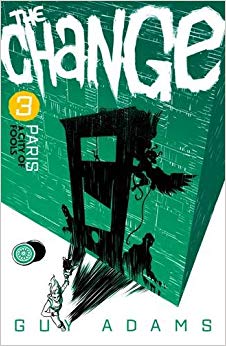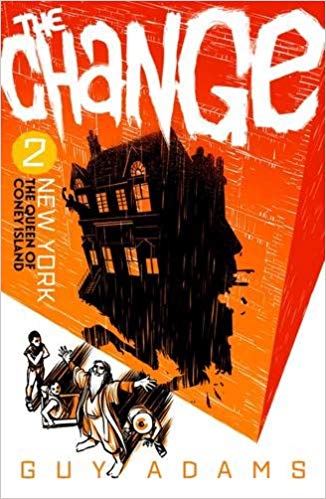-
The Change vol. 6: Tokyo - Noriko's Story
Guy Adams
Paperback (Solaris, )None
-
The Change 3: Paris - A City of Fools
Guy Adams
Paperback (Solaris, )None
-
The Change 2: New York - The Queen of Coney Island
Guy Adams
Paperback (Solaris, )None
-
The nouveau roman and Writing in Britain After Modernism
Adam Guy
eBook (OUP Oxford, Dec. 10, 2019)The nouveau roman and Writing in Britain After Modernism recovers a neglected literary history. In the late 1950s, news began to arrive in Britain of a group of French writers who were remaking the form of the novel. In the work of Michel Butor, Marguerite Duras, Robert Pinget, Alain Robbe-Grillet, Nathalie Sarraute, and Claude Simon, the hallmarks of novelistic writing—discernible characters, psychological depth, linear chronology—were discardedin favour of other aesthetic horizons. Transposed to Britain's highly polarized literary culture, the nouveau roman became a focal point for debates about the novel. For some, the nouveau roman represented an aberration, and a pernicious turn against the humanistic values that the novel embodied. For others, itprovided a route out of the stultifying conventionality and conformism that had taken root in British letters. On both sides, one question persisted: given the innovations of interwar modernism, to what extent was the nouveau roman actually new?This book begins by drawing on publishers' archives and hitherto undocumented sources from a wide range of periodicals to show how the nouveau roman was mediated to the British public. Of central importance here is the publisher Calder & Boyars, and its belief that the nouveau roman could be enjoyed by a mass public. The book then moves onto literary responses in Britain to the nouveau roman, focusing on questions of translation, realism, the end of empire, andthe writing of the project. From the translations of Maria Jolas, through to the hostile responses of the circle around C. P. Snow, and onto the literary debts expressed in novels by Brian W. Aldiss, Christine Brooke-Rose, Eva Figes, B. S. Johnson, Alan Sheridan, Muriel Spark, and Denis Williams, the nouveau roman is shown to be acentral concern in the postwar British literary field.
-
Adam Gay XXX Showcase Magazine Johnny Hazzard vol.13 #12 2006
Adam
Single Issue Magazine (knight publishing, March 15, 2006)None
-
The Chinese: Or, Some Short Accounts of the Country and People of China
Adam Adam
Hardcover (Forgotten Books, Feb. 13, 2019)Excerpt from The Chinese: Or, Some Short Accounts of the Country and People of ChinaGood things are often put to bad purposes Barley is a useful grain, but people often drink too freely of the malt liquor that is made from it-grapes are excellent fruit, but how many are there who injure themselves with the brandy procured from them - Opium is made from poppies - Poppies are grown in abundance in Turkey and the East Indies - Manner of gathering opium - Bad effects of chewing and smoking Opium.About the PublisherForgotten Books publishes hundreds of thousands of rare and classic books. Find more at www.forgottenbooks.comThis book is a reproduction of an important historical work. Forgotten Books uses state-of-the-art technology to digitally reconstruct the work, preserving the original format whilst repairing imperfections present in the aged copy. In rare cases, an imperfection in the original, such as a blemish or missing page, may be replicated in our edition. We do, however, repair the vast majority of imperfections successfully; any imperfections that remain are intentionally left to preserve the state of such historical works.
-
The Chinese: Or, Some Short Accounts of the Country and People of China
Adam Adam
Paperback (Forgotten Books, Feb. 13, 2019)Excerpt from The Chinese: Or, Some Short Accounts of the Country and People of ChinaGood things are often put to bad purposes Barley is a useful grain, but people often drink too freely of the malt liquor that is made from it-grapes are excellent fruit, but how many are there who injure themselves with the brandy procured from them - Opium is made from poppies - Poppies are grown in abundance in Turkey and the East Indies - Manner of gathering opium - Bad effects of chewing and smoking Opium.About the PublisherForgotten Books publishes hundreds of thousands of rare and classic books. Find more at www.forgottenbooks.comThis book is a reproduction of an important historical work. Forgotten Books uses state-of-the-art technology to digitally reconstruct the work, preserving the original format whilst repairing imperfections present in the aged copy. In rare cases, an imperfection in the original, such as a blemish or missing page, may be replicated in our edition. We do, however, repair the vast majority of imperfections successfully; any imperfections that remain are intentionally left to preserve the state of such historical works.
-
I'm Ready To Crush 5th Grade: Composition Notebook Dabbing Unicorn, Wide Ruled Composition Notebook, Funny Back To School Notebook, Gift for 5th Grade ... 100 Blank Pages 8.5x11" Glossy Finish Cover
Adam Adam
Paperback (Independently published, Aug. 7, 2020)♥ Cute Dabbing Unicorn Composition Notebook ♥✓ 100 Wide Ruled pages✓ Duo sided wide lined sheets✓ Perfect Glossy softcover ★★★★★✓ 8.5" x 11" dimensions perfect size for your purse, tote bag, desk, backpack, school, home or work✓ Can be used as a notebook, journal, diary for your home office and work✓ Perfectly suited for taking notes, writing, organizing, lists, journaling, and brainstorming
-
A.d.a.m. Nine Month Miracle
ADAM
Diskette (A, )None
-
fisica Composition book: Esercizi e note 6x9 inch 120 pagine con un bellissimo sfondo
adam
Paperback (Independently published, Aug. 14, 2020)It can be used as a notebook, journal or composition book. This paperback notebook is 6x9 and has 100 sheets. This is the standard for composition or writing books for school. It is also a good choice for ‘casual’ writing notebooks for teens. Cute Notebooks are perfect for Birthday Gifts, Christmas Gifts, Gifts for Graduating Students, Co-worker/Boss Gifts, Journals & Planners, Gift Baskets & Stocking Stuffers.
-
Color by Number by Adam, Winky, Coloring Books
Adam
Paperback (Dover Publications, 2006, )Color by Number by Adam, Winky, Coloring Books [Dover Publications, 2006] Pap...
-
Composition Notebooks: Beautiful mermaid for girl
adam
Paperback (Independently published, Aug. 12, 2020)For girls An elegant and beautiful note, suitable , size 69 and 120 pages